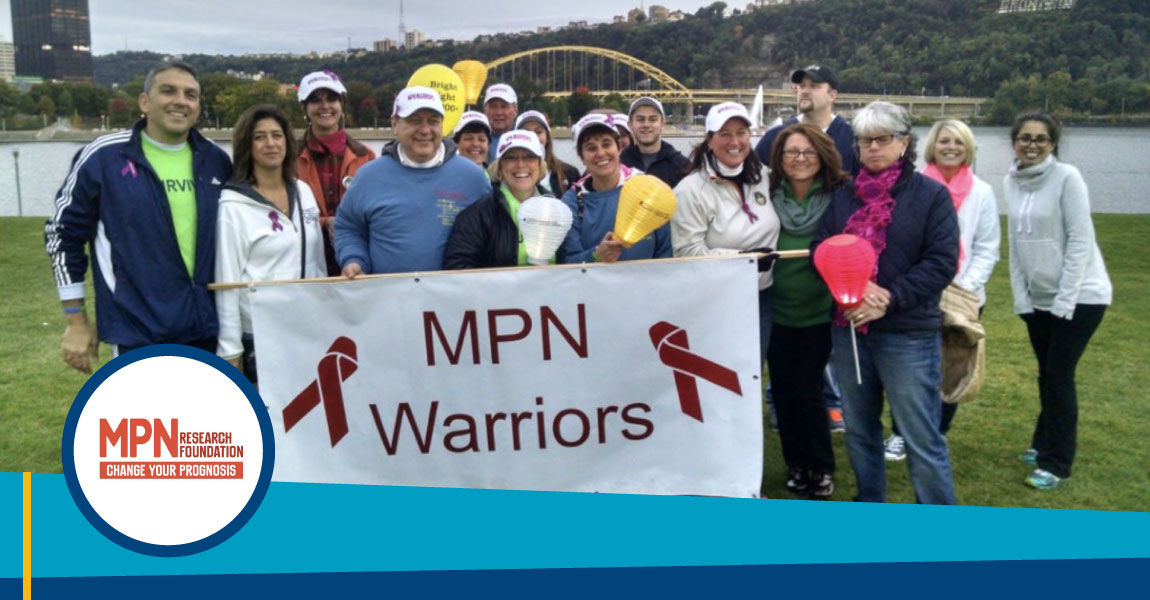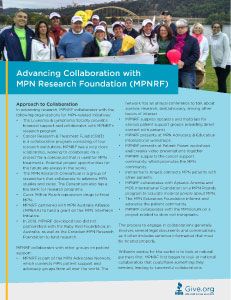
Advancing Collaboration with MPN Research Foundation (MPNRF)
About the Organization
“The mission of the MPN Research Foundation is to stimulate original research in pursuit of new treatments — and eventually a cure — for the blood cancers polycythemia vera, essential thrombocythemia, and myelofibrosis, known collectively as myeloproliferative neoplasms (MPN).” The patient population for the 3 groups is about 300,000 in the U.S. The MPN Research Foundation (MPNRF) focuses on research almost exclusively.
Featured Guest
William Crowley
Director of
Development
MPN Research Foundation
Approach to Collaboration
In advancing research, MPNRF collaborates with the following organizations for MPN-related initiatives:
- The Leukemia & Lymphoma Society provides financial support and collaborates with MPNRF’s research program.
- Cancer Research & Treatment Fund (CR&T) is a collaborative program consisting of four research institutions. MPNRF has a very close relationship, working to collaborate on a project for a compound that is used for MPN treatments. Potential project opportunities for the future are always in the works.
- The MPN Research Consortium is a group of researchers that collaborate to advance MPN studies and cures. The Consortium also has a Bio Bank for research programs.
- Cures Within Reach repurposes drugs to treat MPN.
- MPNRF partnered with MPN Australia Alliance (MPNAA) to fund a grant on the MPN Interferon Initiative.
- In 2019, MPNRF developed two distinct partnerships with the Ruby Red Foundation, in Australia, as well as the Canadian MPN Research Foundation to fund research.
MPNRF collaborates with other groups on patient support:
- MPNRF is part of the MPN Advocates Network, which connects MPN patient support and advocacy groups from all over the world. The network has an annual conference to talk about science, research, and advocacy, among other topics of interest.
- MPNRF supplies speakers and materials for various patient support groups providing direct contact with patients.
- MPNRF presents at MPN Advocacy & Education International workshops.
- MPNRF presents at Patient Power workshops and creates video presentations together.
- MPNRF supports the cancer support community, which promotes the MPN community.
- Immerman’s Angels connects MPN patients with other patients.
- MPNRF collaborates with Aplastic Anemia and MDS International Foundation on a MPN Rounds program to educate medical people about MPN.
- The MPN Education Foundation informs and educates the patient community.
- MPNRF collaborates with the MPNforum on a project related to stem cell transplants.
The process to engage in collaborations generally involves several legal documents and conversations, as it often includes sensitive information that must be treated properly.
William’s advice for the sector is to look at natural partners first. MPNRF first began to look at national collaborators that could have something they needed, leading to successful collaborations.
Application of the 9 Considerations for Collaboration
Build Trust
MPNRF has built trust with partners by demonstrating high performance and outcomes in their area of interest. They are cautious in their relationship with the pharmaceutical industry to protect MPNRF’s reputation. While working with this industry to promote research, they make sure not to benefit one pharmaceutical company over another, staying completely neutral when it comes to drug development.
Have a Vision
Until now, MPNRF had just talked about 5-year plans to envision what MPNRF and the research environment will look like in 2022-2023. Now, they look further out to be prepared for the challenges of the future. For example, a big part of William’s job consists of analyzing the pharmaceutical industry and the compounds that companies are developing. They often observe a high-level of innovation moving very fast. This process is imperative for MPNRF’s future planning.
Seek to Assure the Success of Your Collaborators
When MPNRF discovered a vaccine trial in Denmark for one of the diseases they focus on, MPNRF began posting information on its website to promote it, using its connection with MPN patients around the world. MPNRF does this with other clinical trials too, seeking to assure the success of its collaborators, requiring that their trials are popularized as quickly as possible to ensure successful drug developments. This is also beneficial to MPNRF and the MPN community. In their work with patient groups, they keep group members updated on what is happening in research. This allows MPNRF to connect with people that could make donations to their organization. This acts as a symbiotic relationship, where each party receives great benefit from the partnership.
Take Stock
MPNRF’s approach to patient support is a good example of taking stock. A few years ago, they decided to focus on where MPNRF is strongest, in research instead of patient support. This led to the decision to come alongside the work of other patient support organizations that are focused on this area. Also, MPNRF develops research programs on different topics by gathering experts and organizations to support these activities. MPNRF looks closely at what others are doing to leverage the best resources. For this purpose, it is essential to take stock and understand everyone’s strengths and needs.
Start Small
More than starting small, William believes in starting slowly. MPNRF is part of the global MPN Advocates Network. In the beginning, MPNRF was not sure how much of their time and resources to invest there. By starting slowly with that network, MPNRF has been able to build strong relationships and many doors have opened for new projects.
Fail Fast, and Build Rigorous Feedback Loops
The MPN Research Challenge is a program to collect research proposals from the public. They send out information about what the public is interested in researching and ask for proposals. MPNRF contracts with a person who oversees the process, the research, and to ensure everything is going well. Thanks to this oversight, they were able to identify which research projects are worth investing in.
Take a Portfolio Approach
As it has been shown above, MPNRF has a wide portfolio of collaborations. This wide portfolio has made collaborations possible between institutions that had not worked together before. Examples of this are the collaborations it has seen between pharmaceutical companies that have met at roundtables powered by MPNRF.
Consider Non-traditional Partners
MPNRF has not done this yet because its area is very specialized. However, it has engaged in collaborations with organizations related to other kinds of diseases, like prostate cancer.
Keep Your Donors Apprised of Your Collaborations
MPNRF has newsletters and a monthly digest it sends to donors. They are also very active on social media, demonstrating to their audience MPNRF’s work and collaborations.
This article was composed by Rachel Romana Liu.



